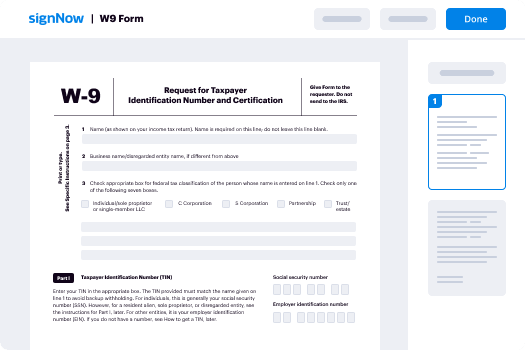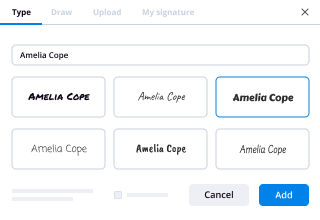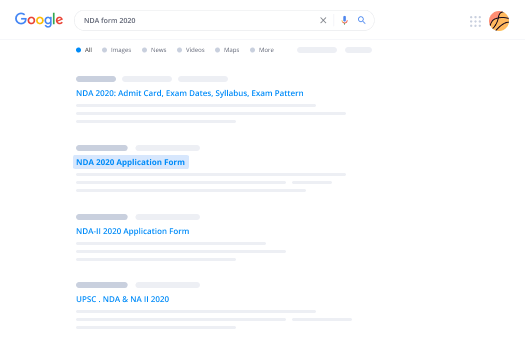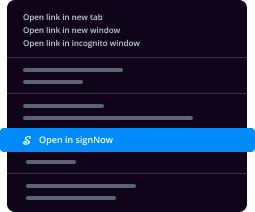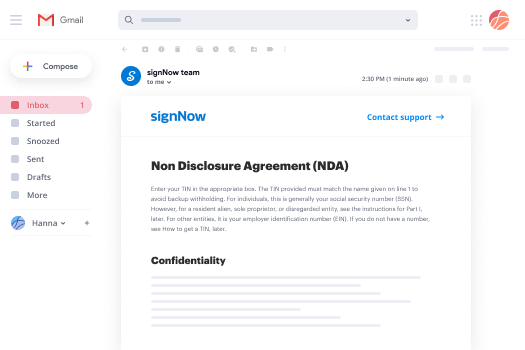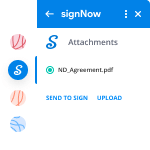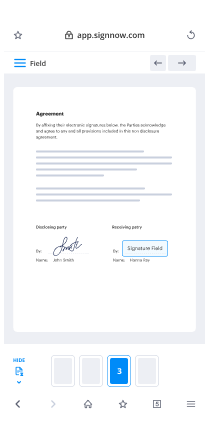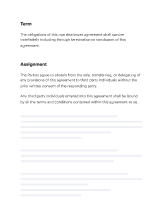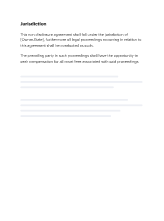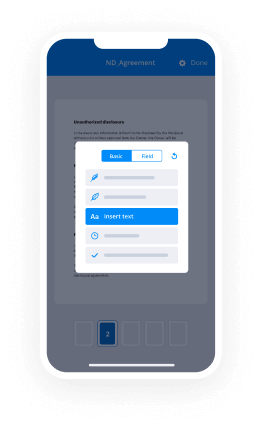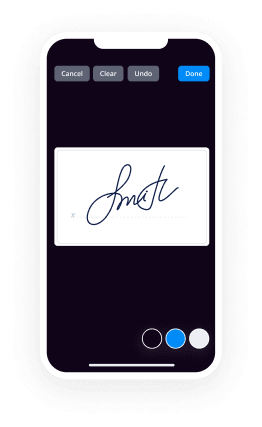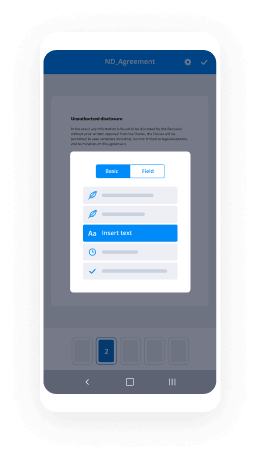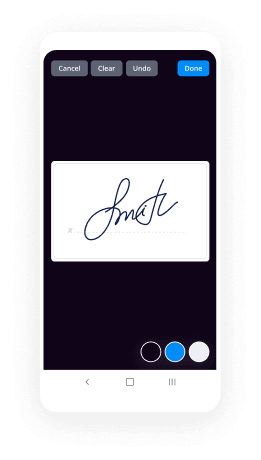Signature Numérique Vs Signature électronique
- Démarrage rapide
- Facile à utiliser
- Support 24/7
Les entreprises qui pensent à l'avance dans le monde entier font confiance à airSlate pour le moment






Guide rapide sur l'utilisation de la fonctionnalité digital vs electronic
Votre organisation est-elle prête à réduire les inefficacités de trois quarts ou plus ? Avec airSlate SignNow eSignature, des semaines de négociation de contrats deviennent des jours, et des heures de collecte de signatures se transforment en quelques minutes. Vous n'aurez pas besoin d'apprendre tout depuis le début grâce à l'interface intuitive et aux instructions faciles à suivre.
Suivez les étapes ci-dessous pour utiliser la fonctionnalité digital vs electronic sign en quelques minutes :
- Lancez votre navigateur et visitez signnow.com.
- Inscrivez-vous pour un essai gratuit ou connectez-vous en utilisant votre adresse électronique ou vos identifiants Google/Facebook.
- Cliquez sur Avatar de l'utilisateur -> Mon compte dans le coin supérieur droit de la page web.
- Personnalisez votre Profil utilisateur avec vos données personnelles et ajustez les configurations.
- Concevez et gérez votre (vos) Signature(s) par défaut.
- Retournez à la page du tableau de bord.
- Survolez le bouton Télécharger et créer et choisissez l'option appropriée.
- Cliquez sur le bouton Préparer et envoyer à côté du titre du document.
- Entrez le nom et l'adresse e-mail de tous les signataires dans la boîte pop-up qui s'ouvre.
- Utilisez l'option Commencer à ajouter des champs pour modifier le fichier et le signer vous-même.
- Cliquez sur ENREGISTRER ET INVITER une fois terminé.
- Continuez à configurer votre flux de travail eSignature en utilisant d'autres fonctionnalités.
Il n'a jamais été aussi facile d'utiliser la fonctionnalité digital vs electronic signature. Elle est également disponible sur vos appareils mobiles. Installez l'application airSlate SignNow pour iOS ou Android et gérez vos flux de travail eSignature personnalisés même en déplacement. Mettez de côté l'impression et la numérisation, le classement chronophage et l'expédition de documents coûteux.
Comment ça marche
Évaluez votre expérience
What is digital vs electronic?
The terms "digital" and "electronic" are often used interchangeably, but they have distinct meanings, especially in the context of signatures. A digital signature is a specific type of electronic signature that uses cryptographic techniques to secure the authenticity and integrity of a document. Electronic signatures, on the other hand, encompass a broader range of methods for signing documents electronically, including scanned handwritten signatures, typed names, or clicks to accept terms. Understanding this distinction is crucial when navigating the eSignature process.
Steps to complete the digital vs electronic
Completing a document using digital or electronic signatures involves several key steps:
- Upload the document to airSlate SignNow’s platform.
- Choose the signature method: digital or electronic.
- Fill out any required fields within the document.
- Request signatures from other parties by entering their email addresses.
- Send the document for signature.
- Once all parties have signed, the completed document is securely stored and can be downloaded.
Legal use of the digital vs electronic
In the United States, both digital and electronic signatures are legally recognized under the Electronic Signatures in Global and National Commerce (ESIGN) Act and the Uniform Electronic Transactions Act (UETA). These laws establish that electronic signatures hold the same legal weight as traditional handwritten signatures, provided that all parties consent to use electronic means for signing. It is essential for users to ensure compliance with these regulations when utilizing eSignatures in their workflows.
Security & Compliance Guidelines
When using digital or electronic signatures, security and compliance are paramount. Users should consider the following guidelines:
- Utilize platforms like airSlate SignNow that offer encryption and secure storage for documents.
- Ensure that the identity of signers is verified through multi-factor authentication.
- Maintain an audit trail that logs all actions taken on the document, including who signed and when.
- Regularly review and update security protocols to align with industry standards.
Examples of using the digital vs electronic
Digital and electronic signatures can be applied across various scenarios, including:
- Contracts: Businesses can quickly finalize agreements without the need for physical meetings.
- HR documents: Employee onboarding forms can be signed electronically, streamlining the hiring process.
- Legal documents: Attorneys can send and receive signed documents securely, ensuring confidentiality.
- Real estate transactions: Buyers and sellers can sign agreements remotely, expediting the closing process.
Sending & Signing Methods (Web / Mobile / App)
airSlate SignNow provides flexible options for sending and signing documents. Users can:
- Access the platform via a web browser for desktop signing.
- Use the mobile app to sign documents on the go, ensuring convenience.
- Send documents for signature directly from integrated tools like Google Docs or CRM systems.
Obtenez dès maintenant des signatures juridiquement contraignantes !
-
Meilleur ROI. Nos clients obtiennent un ROI 7 fois en moyenne au cours des six premiers mois.
-
Échelle avec vos cas d'utilisation. De SMB à moyen marché, airSlate SignNow fournit des résultats pour les entreprises de toutes tailles.
-
Interface utilisateur intuitive et API. Signez et envoyez des documents depuis vos applications en quelques minutes.
Signature en ligne de la FAQ
-
What is the difference between digital vs electronic signatures?
Digital signatures use cryptographic techniques to provide a higher level of security and authenticity, while electronic signatures are a broader category that includes any electronic indication of agreement. Understanding the difference between digital vs electronic signatures is crucial for businesses looking to ensure compliance and security in their document processes. -
How does airSlate SignNow handle digital vs electronic signatures?
airSlate SignNow offers both digital and electronic signature options, allowing users to choose the method that best fits their needs. This flexibility ensures that businesses can comply with various regulations while enjoying the benefits of a streamlined signing process. -
What are the pricing options for airSlate SignNow?
airSlate SignNow provides various pricing plans to accommodate different business sizes and needs. By comparing the features included in each plan, you can determine which option best supports your requirements for managing digital vs electronic signatures. -
What features does airSlate SignNow offer for managing documents?
airSlate SignNow includes features such as customizable templates, automated workflows, and real-time tracking of document status. These tools enhance the efficiency of managing both digital vs electronic signatures, making it easier for businesses to streamline their document processes. -
Can airSlate SignNow integrate with other software?
Yes, airSlate SignNow integrates seamlessly with various third-party applications, including CRM and project management tools. This capability allows businesses to enhance their workflows and manage digital vs electronic signatures more effectively across different platforms. -
What are the benefits of using airSlate SignNow for electronic signatures?
Using airSlate SignNow for electronic signatures offers numerous benefits, including increased efficiency, reduced paper usage, and enhanced security. By understanding the advantages of digital vs electronic signatures, businesses can make informed decisions that improve their overall document management processes. -
Is airSlate SignNow compliant with legal standards for signatures?
Yes, airSlate SignNow complies with various legal standards, including the ESIGN Act and UETA, ensuring that both digital and electronic signatures are legally binding. This compliance is essential for businesses that want to ensure the validity of their signed documents.
Votre guide complet
Solution eSignature de confiance
Rejoignez plus de 28 millions d'utilisateurs airSlate
Obtenir plus
- Découvrez comment changer la police de signature dans ...
- Découvrez comment changer facilement votre signature ...
- Découvrez comment changer la signature dans Outlook ...
- Comment changer la signature dans Outlook
- Découvrez comment changer de signature dans Adobe ...
- Déverrouillez le pouvoir du changement : Découvrez ...
- Apprenez à changer la signature dans un e-mail dans ...
- Apprenez à changer vous-même de signature dans Adobe ...




















